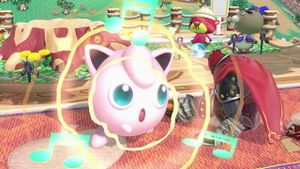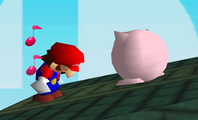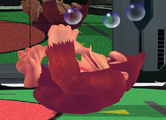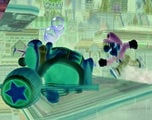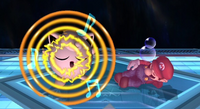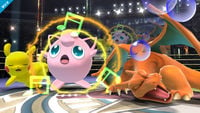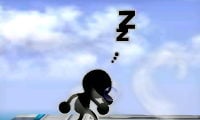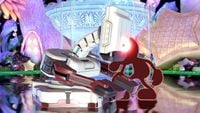Asleep: Difference between revisions
mNo edit summary |
m (→Trivia) |
||
| (64 intermediate revisions by 33 users not shown) | |||
| Line 1: | Line 1: | ||
{{ArticleIcons| | {{ArticleIcons|allgames=y}} | ||
[[ | {{disambig2|status condition|the effect and moves that cause the status condition|sleep}} | ||
''' | [[File:SSBUWebsiteJigglypuff3.jpg|300px|thumb|{{SSBU|Ganondorf}} falls asleep from {{SSBU|Jigglypuff}}'s [[Sing]] in ''[[Super Smash Bros. Ultimate]]''.]] | ||
Being '''asleep''' (known as '''FuraSleep''' by the games' internal files, with "fura" being the Japanese onomatopoeia for dizziness) is a status condition in every ''Super Smash Bros.'' game to date, which is inflicted by attacks with the [[sleep]] effect. A character that falls asleep is prevented from taking action until waking up or getting hit by an attack. | |||
In ''Super Smash Bros.'', | ==General properties== | ||
Any fighter on the ground hit by an attack with a sleep effect will be put to sleep. In the air, characters cannot be put to sleep prior to ''[[Super Smash Bros. 4]]''; from this game onward, a few sleeping moves are allowed to hit aerial opponents, namely [[Peach]]'s [[Peach Blossom]] and the [[Hero]]'s [[Snooze]], in which case the opponent is instead put in an inactionable [[tumble]] state, transitioning into their sleeping animation if they land on the ground. The sleeping animation has a unique voice clip, which is more often than not the character snoring and occasionally sleep-talking. | |||
Sleeping characters cannot take any action until waking up, though they can decrease its duration by [[button mashing]], and it ends prematurely if they take any kind of [[knockback]], or if the ground they are standing on disappears. As with other status conditions, its duration increases proportionally with the target's [[damage]] percentage. | |||
In {{forwiiu}}{{'}}s [[Smash Tour]], the tour item [[Darkrai]] causes an opponent to be asleep at the start of the battle. In ''Ultimate'', the slumber floor [[Spirit Battle]] [[condition]] causes a stage's floor to put players (but not opponents) who stand on it to sleep. Conversely, the support [[spirit]] skill Slumber Immunity prevents the equipped fighter from falling asleep. | |||
Uniquely, [[Donkey Kong]] cannot fall asleep while carrying a heavy item. Additionally, he cannot fall asleep while carrying an opponent in ''Brawl'', but he can in ''Melee''. | |||
===Appearance=== | |||
In the original ''Super Smash Bros.'', {{SSB|Jigglypuff}}'s [[Sing]] is the only way characters can be put to sleep. The animation for sleeping characters is also the same as the animation for getting [[stun]]ned, except the sleeping character flashes different colors, has musical notes around them, and uses a different voice clip to indicate being asleep, such as {{SSB|Mario}} using his snoring voice clip from ''Super Mario 64''. | |||
From ''Melee'' onward, all characters have a unique sleeping animation, as well as an animation for waking up. For example, [[Donkey Kong]] rocks on his back and puts his thumb in his mouth, and [[Fox]] curls up on the ground like his real-world animal counterpart. In ''Ultimate'', {{SSBU|Steve}} takes out a Bed from ''Minecraft'' and lies upon it, then breaks it and places it back in his inventory upon waking up. Sleeping characters also flash magenta, and emit stylized "bubbles" from their faces. In ''Melee'', {{SSBM|Mr. Game & Watch}} emits stylized Z's instead of bubbles; from ''Brawl'' onward, both the bubbles and Z's are shown. | |||
In ''Melee'' only, {{SSBM|Mario}}, {{SSBM|Luigi}}, {{SSBM|Dr. Mario}}, {{SSBM|Captain Falcon}}, {{SSBM|Sheik}}, {{SSBM|Yoshi}}, {{SSBM|Bowser}}, {{SSBM|Ganondorf}}, {{SSBM|Young Link}} and {{SSBM|Mr. Game & Watch}} emit their stun voice clip upon waking up without being interrupted by knockback. Starting with ''Smash 4'', most newcomers and a number of veterans also have a similar (albeit unique) voice clip, often being a gasp or a quiet breathe; in ''Smash 4'', this applied to most voiced newcomers (with the exception of {{SSB4|Rosalina & Luma}}, {{SSB4|Greninja}}, {{SSB4|Bowser Jr.}}, {{SSB4|Lucina}}, {{SSB4|Dark Pit}} and {{SSB4|Duck Hunt}}) plus {{SSB4|Mewtwo}}; ''Ultimate'' adds all voiced newcomers from that game (minus {{SSBU|Inkling}} and {{SSBU|Ridley}}; including {{SSBU|Daisy}} and {{SSBU|Chrom}}, whereas their base counterparts don't have one), as well as {{SSBU|Link}}, {{SSBU|Young Link}}, {{SSBU|Zelda}}, {{SSBU|Ganondorf}}, {{SSBU|Wolf}}, and the {{SSBU|Mii Fighter}}s. | |||
==Sleep duration== | |||
As mentioned prior, the amount of time characters remain asleep increases proportionally to their percent, but can be reduced by button mashing from their part. Additionally, from ''Melee'' onward, characters have an animation for waking up that cannot be [[interrupt]]ed (known as '''FuraSleepEnd''' internally), effectively adding extra vulnerability time. This animation generally lasts 60 [[frame]]s (exactly one second), though prior to ''Ultimate'', it is different for a few characters; it lasts 50 frames for {{SSBM|Mewtwo}} in ''Melee'', 76 frames for [[Kirby]] and [[Jigglypuff]] from ''Melee'' to ''Smash 4'', and a much shorter 30 frames for {{SSBB|Squirtle}} in ''Brawl''. In ''Smash 4'' and earlier versions of ''Ultimate'', the duration was either 59 or 60 frames for the rest of the cast, which was completely standardized to 59 frames since version {{SSBU|4.0.0}} of ''Ultimate''. | |||
In ''Smash 64'', sleeping works differently from every other game in that its duration ''decreases'' when the opponent is at higher percents, much like getting [[stun]]ned from a [[shield break]]. Additionally, characters do not have animations for waking up, allowing them to initiate other actions immediately after their sleep duration ends. In this game, the formula for sleep frames is <code>(300 - p) + 75</code>, rounded down, where '''p''' is the character's damage percent after the sleeping move hits, and [[button mashing]] reduces this duration by 4 frames per input. This makes it more or less the same as the formula for stun frames, except with a lower base duration and reaching its limit faster (when the opponent has at least 300% damage). | |||
In ''Melee'', the formula for sleep time is <code>95 + 2p - 15h</code>, where '''p''' is the same as in ''Smash 64'', and '''h''' is a handicap equal to the victim's current rank disadvantage over the attacker (for example, if the victim is placing 4th and the attacker is placing 1st, it is equal to 3). As a result, players that are currently losing will be put to sleep for less time, and the minimum possible sleep time without button mashing can be 95, 80, 65, or 50 frames depending on their rank disadvantage. Button mashing reduces sleep time by 6 frames per input. | |||
From ''Brawl'' onward, the formula is changed to <code>10 + 30h + 10(3 - r) + p + 25k</code>, rounded up, with the factors corresponding to the following: | |||
*'''h''' and '''r''' are both placing factors much like the one used in ''Melee'', but they make sleep time even more variable based on the user and victim's stock difference (or points in a time battle). '''h''' (handicap) is equal to 1.225 if the user is one stock behind the opponent, 1.45 with two or more stocks behind, 0.5 with one stock ahead, and 0.25 with two or more stocks ahead. On the other hand, '''r''' (rank) is equal to 0.32 if the user is one stock ahead of the opponent, and 0.4 with two or more stocks ahead. | |||
**If both characters' stocks (or points) are equal, '''h''' is equal to 1, while '''r''' is equal to 0, simplifying the formula to <code>70 + p + 25k</code>. | |||
**To summarize, characters put opponents to sleep for 7 more frames with a -1 difference in stocks (or points), 14 more frames with a -2 difference or lower, 18 less frames with a +1 difference, and 26 less frames with a +2 difference or higher. | |||
*'''p''' takes the [[1v1 multiplier]] into account in ''Ultimate'' (though most attacks with the sleep effect deal no damage). | |||
*'''k''' is the numerical [[knockback]] amount inflicted by the sleeping attack, using a [[weight]] of 100 for every character. | |||
*Button mashing reduces sleep time by 8 frames per input (14.4 for buttons in ''Smash 4'' and ''Ultimate'', but they cannot be inputted as quickly as stick inputs). | |||
In ''Smash 64'' and ''Melee'', unlike with other status conditions, characters that are already asleep can still be fully affected by subsequent sleeping moves, resetting their sleep duration. While this has no practical use in ''Smash 64'', due to the sleep duration being short and incurring no wakeup animation, in ''Melee'', {{SSBM|Jigglypuff}} can [[ledge]]-cancel Sing and repeatedly put an opponent to sleep if they are in range, allowing it to [[stall]] the match indefinitely. However, this is rarely seen in competitive play due to the extreme difficulty in landing Sing, as well as its punishability if unsuccessful. From ''Brawl'' onward, sleeping moves have no effect on characters that are already asleep, even during their wakeup animation, ensuring they can always [[shield]] and avoid immediately going into the status again. | |||
Contrary to common misconception, [[Jigglypuff]]'s [[Rest]] does not inflict the asleep status on it, and thus cannot be ended faster by button mashing; it is simply extremely high [[ending lag]] manifested through a sleeping animation. | |||
==Gallery== | ==Gallery== | ||
<gallery widths="200"> | <gallery widths="200"> | ||
SSB Mario Sleep.png|Mario sleeping in ''[[Smash 64]]'' | |||
Melee DK Sleep.png|Donkey Kong sleeping in ''[[Melee]]'' | |||
NegativeZone2.jpg|[[King Dedede]] sleeping due to [[Negative Zone]], [[Luigi]]'s [[Final Smash]] in ''[[Brawl]]'' | |||
Sing sleep.png|{{SSBB|Mario}} falls asleep from {{SSBB|Jigglypuff}}'s [[Sing]] in ''Brawl'' | |||
SSB4 - Jigglypuff screen-1.jpg|Jigglypuff putting [[Charizard]] and [[Pikachu]] to sleep in one of Jigglypuff's Wii U pictures on the ''[[Super Smash Bros. 4]] website'' | |||
Mr. Game & Watch Sleeping.jpg|{{SSB4|Mr. Game & Watch}} sleeping in the 3DS version of ''Super Smash Bros. 4'' | |||
Mr. Game & Watch and R.O.B. Sleeping in Super Smash Bros. Ultimate.jpg|300px|thumb|{{SSBU|Mr. Game & Watch}} and {{SSBU|R.O.B.}} sleeping in ''[[Super Smash Bros. Ultimate]]'' | |||
</gallery> | </gallery> | ||
==Trivia== | ==Trivia== | ||
* | *{{SSBU|Richter}} has a voice clip where he mutters "[[Dracula]]..." while sleeping that can be heard in the [[Sound Test]], but the clip lasts longer than his sleeping animation, causing the voice clip to loop prematurely in-game. | ||
**The voice clip doesn't loop if Richter is put to sleep by {{SSBU|Hero}}'s Snooze while airborne, but there are very few situations where Richter can be in the air long enough for this to occur. | |||
*Although the Villager has a canon sleeping pose in ''{{iw|nookipedia|Animal Crossing: Wild World}}'' and ''{{iw|nookipedia|Animal Crossing: City Folk}}'', both ''Smash 4'' and ''Ultimate'' give them different poses. | |||
*Some characters' sleeping animations reference their home franchise: | |||
**In ''Melee'' onwards, Mario sleeps in his 'laying sleeping' pose from ''{{iw|mariowiki|Super Mario 64}}''. | |||
**Kirby is in his signature {{iw|wikirby|Sleep}} ability pose, albeit without the sleeping hat. | |||
**{{SSBU|Steve}} places a red bed and sleeps on it. When he wakes up, he collects it back in his inventory. | |||
[[Category:Special conditions]] | [[Category:Special conditions]] | ||
Latest revision as of 22:24, December 23, 2024
Being asleep (known as FuraSleep by the games' internal files, with "fura" being the Japanese onomatopoeia for dizziness) is a status condition in every Super Smash Bros. game to date, which is inflicted by attacks with the sleep effect. A character that falls asleep is prevented from taking action until waking up or getting hit by an attack.
General properties[edit]
Any fighter on the ground hit by an attack with a sleep effect will be put to sleep. In the air, characters cannot be put to sleep prior to Super Smash Bros. 4; from this game onward, a few sleeping moves are allowed to hit aerial opponents, namely Peach's Peach Blossom and the Hero's Snooze, in which case the opponent is instead put in an inactionable tumble state, transitioning into their sleeping animation if they land on the ground. The sleeping animation has a unique voice clip, which is more often than not the character snoring and occasionally sleep-talking.
Sleeping characters cannot take any action until waking up, though they can decrease its duration by button mashing, and it ends prematurely if they take any kind of knockback, or if the ground they are standing on disappears. As with other status conditions, its duration increases proportionally with the target's damage percentage.
In Super Smash Bros. for Wii U's Smash Tour, the tour item Darkrai causes an opponent to be asleep at the start of the battle. In Ultimate, the slumber floor Spirit Battle condition causes a stage's floor to put players (but not opponents) who stand on it to sleep. Conversely, the support spirit skill Slumber Immunity prevents the equipped fighter from falling asleep.
Uniquely, Donkey Kong cannot fall asleep while carrying a heavy item. Additionally, he cannot fall asleep while carrying an opponent in Brawl, but he can in Melee.
Appearance[edit]
In the original Super Smash Bros., Jigglypuff's Sing is the only way characters can be put to sleep. The animation for sleeping characters is also the same as the animation for getting stunned, except the sleeping character flashes different colors, has musical notes around them, and uses a different voice clip to indicate being asleep, such as Mario using his snoring voice clip from Super Mario 64.
From Melee onward, all characters have a unique sleeping animation, as well as an animation for waking up. For example, Donkey Kong rocks on his back and puts his thumb in his mouth, and Fox curls up on the ground like his real-world animal counterpart. In Ultimate, Steve takes out a Bed from Minecraft and lies upon it, then breaks it and places it back in his inventory upon waking up. Sleeping characters also flash magenta, and emit stylized "bubbles" from their faces. In Melee, Mr. Game & Watch emits stylized Z's instead of bubbles; from Brawl onward, both the bubbles and Z's are shown.
In Melee only, Mario, Luigi, Dr. Mario, Captain Falcon, Sheik, Yoshi, Bowser, Ganondorf, Young Link and Mr. Game & Watch emit their stun voice clip upon waking up without being interrupted by knockback. Starting with Smash 4, most newcomers and a number of veterans also have a similar (albeit unique) voice clip, often being a gasp or a quiet breathe; in Smash 4, this applied to most voiced newcomers (with the exception of Rosalina & Luma, Greninja, Bowser Jr., Lucina, Dark Pit and Duck Hunt) plus Mewtwo; Ultimate adds all voiced newcomers from that game (minus Inkling and Ridley; including Daisy and Chrom, whereas their base counterparts don't have one), as well as Link, Young Link, Zelda, Ganondorf, Wolf, and the Mii Fighters.
Sleep duration[edit]
As mentioned prior, the amount of time characters remain asleep increases proportionally to their percent, but can be reduced by button mashing from their part. Additionally, from Melee onward, characters have an animation for waking up that cannot be interrupted (known as FuraSleepEnd internally), effectively adding extra vulnerability time. This animation generally lasts 60 frames (exactly one second), though prior to Ultimate, it is different for a few characters; it lasts 50 frames for Mewtwo in Melee, 76 frames for Kirby and Jigglypuff from Melee to Smash 4, and a much shorter 30 frames for Squirtle in Brawl. In Smash 4 and earlier versions of Ultimate, the duration was either 59 or 60 frames for the rest of the cast, which was completely standardized to 59 frames since version 4.0.0 of Ultimate.
In Smash 64, sleeping works differently from every other game in that its duration decreases when the opponent is at higher percents, much like getting stunned from a shield break. Additionally, characters do not have animations for waking up, allowing them to initiate other actions immediately after their sleep duration ends. In this game, the formula for sleep frames is (300 - p) + 75, rounded down, where p is the character's damage percent after the sleeping move hits, and button mashing reduces this duration by 4 frames per input. This makes it more or less the same as the formula for stun frames, except with a lower base duration and reaching its limit faster (when the opponent has at least 300% damage).
In Melee, the formula for sleep time is 95 + 2p - 15h, where p is the same as in Smash 64, and h is a handicap equal to the victim's current rank disadvantage over the attacker (for example, if the victim is placing 4th and the attacker is placing 1st, it is equal to 3). As a result, players that are currently losing will be put to sleep for less time, and the minimum possible sleep time without button mashing can be 95, 80, 65, or 50 frames depending on their rank disadvantage. Button mashing reduces sleep time by 6 frames per input.
From Brawl onward, the formula is changed to 10 + 30h + 10(3 - r) + p + 25k, rounded up, with the factors corresponding to the following:
- h and r are both placing factors much like the one used in Melee, but they make sleep time even more variable based on the user and victim's stock difference (or points in a time battle). h (handicap) is equal to 1.225 if the user is one stock behind the opponent, 1.45 with two or more stocks behind, 0.5 with one stock ahead, and 0.25 with two or more stocks ahead. On the other hand, r (rank) is equal to 0.32 if the user is one stock ahead of the opponent, and 0.4 with two or more stocks ahead.
- If both characters' stocks (or points) are equal, h is equal to 1, while r is equal to 0, simplifying the formula to
70 + p + 25k. - To summarize, characters put opponents to sleep for 7 more frames with a -1 difference in stocks (or points), 14 more frames with a -2 difference or lower, 18 less frames with a +1 difference, and 26 less frames with a +2 difference or higher.
- If both characters' stocks (or points) are equal, h is equal to 1, while r is equal to 0, simplifying the formula to
- p takes the 1v1 multiplier into account in Ultimate (though most attacks with the sleep effect deal no damage).
- k is the numerical knockback amount inflicted by the sleeping attack, using a weight of 100 for every character.
- Button mashing reduces sleep time by 8 frames per input (14.4 for buttons in Smash 4 and Ultimate, but they cannot be inputted as quickly as stick inputs).
In Smash 64 and Melee, unlike with other status conditions, characters that are already asleep can still be fully affected by subsequent sleeping moves, resetting their sleep duration. While this has no practical use in Smash 64, due to the sleep duration being short and incurring no wakeup animation, in Melee, Jigglypuff can ledge-cancel Sing and repeatedly put an opponent to sleep if they are in range, allowing it to stall the match indefinitely. However, this is rarely seen in competitive play due to the extreme difficulty in landing Sing, as well as its punishability if unsuccessful. From Brawl onward, sleeping moves have no effect on characters that are already asleep, even during their wakeup animation, ensuring they can always shield and avoid immediately going into the status again.
Contrary to common misconception, Jigglypuff's Rest does not inflict the asleep status on it, and thus cannot be ended faster by button mashing; it is simply extremely high ending lag manifested through a sleeping animation.
Gallery[edit]
Mario sleeping in Smash 64
Donkey Kong sleeping in Melee
King Dedede sleeping due to Negative Zone, Luigi's Final Smash in Brawl
Mario falls asleep from Jigglypuff's Sing in Brawl
Jigglypuff putting Charizard and Pikachu to sleep in one of Jigglypuff's Wii U pictures on the Super Smash Bros. 4 website
Mr. Game & Watch sleeping in the 3DS version of Super Smash Bros. 4
Mr. Game & Watch and R.O.B. sleeping in Super Smash Bros. Ultimate
Trivia[edit]
- Richter has a voice clip where he mutters "Dracula..." while sleeping that can be heard in the Sound Test, but the clip lasts longer than his sleeping animation, causing the voice clip to loop prematurely in-game.
- The voice clip doesn't loop if Richter is put to sleep by Hero's Snooze while airborne, but there are very few situations where Richter can be in the air long enough for this to occur.
- Although the Villager has a canon sleeping pose in Animal Crossing: Wild World and Animal Crossing: City Folk, both Smash 4 and Ultimate give them different poses.
- Some characters' sleeping animations reference their home franchise:
- In Melee onwards, Mario sleeps in his 'laying sleeping' pose from Super Mario 64.
- Kirby is in his signature Sleep ability pose, albeit without the sleeping hat.
- Steve places a red bed and sleeps on it. When he wakes up, he collects it back in his inventory.
